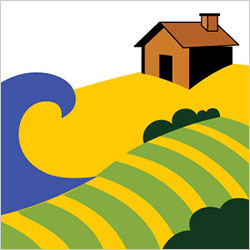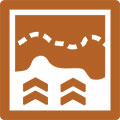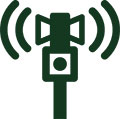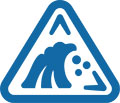 A tsunami is a series of ocean waves caused by large displacement of water, such as earthquakes, underwater landslides, volcanic eruptions, or asteroids. Tsunami can travel 20-30 miles per hour with wave formations of 10-100 feet high. As a tsunami approaches land it causes flooding and disrupt transportation, power, communications, and the water supply. The Pacific Ocean Coast and Caribbean have the greatest tsunami risk in The United States.
A tsunami is a series of ocean waves caused by large displacement of water, such as earthquakes, underwater landslides, volcanic eruptions, or asteroids. Tsunami can travel 20-30 miles per hour with wave formations of 10-100 feet high. As a tsunami approaches land it causes flooding and disrupt transportation, power, communications, and the water supply. The Pacific Ocean Coast and Caribbean have the greatest tsunami risk in The United States.
- A strong earthquake is your warning: Get to high ground as far inland as possible and alert others as you evacuate.
- Be alert to other signs of a tsunami, such as a sudden rise or draining of ocean waters.
- Evacuate: Do not wait! Leave as soon as you see any natural signs of a tsunami or receive an official tsunami warning.
- If you are in a boat, go out to sea.
Prepare Now
 Know and practice community evacuation plans and map out your routes from home, work, and play. Pick shelter 100 feet or more above sea level, or at least one mile inland. To understand whether you live, work or visit tsunami hazard areas, visit the California Geological Survey’s Tsunami Hazard Area Map Application.
Know and practice community evacuation plans and map out your routes from home, work, and play. Pick shelter 100 feet or more above sea level, or at least one mile inland. To understand whether you live, work or visit tsunami hazard areas, visit the California Geological Survey’s Tsunami Hazard Area Map Application.- Create a family emergency communication plan that has an out-of-state contact. Plan where to meet if you get separated.
- Sign up for SoCoAlert. The Emergency Alert System (EAS) and National Oceanic and Atmospheric Administration (NOAA) Weather Radio also provide emergency alerts.
- Consider earthquake insurance and a flood insurance policy through the National Flood Insurance Program (NFIP). Standard homeowner’s insurance does not cover flood or earthquake damage.
Survive During
 If there is a long, strong earthquake, when the shaking stops, move immediately to a safe place as high and as far inland as possible. Listen to the authorities, but do not wait for tsunami warnings and evacuation orders.
If there is a long, strong earthquake, when the shaking stops, move immediately to a safe place as high and as far inland as possible. Listen to the authorities, but do not wait for tsunami warnings and evacuation orders.- If you are outside of the tsunami hazard zone and receive a warning, then stay where you are unless officials tell you otherwise.
- Leave immediately if you are told to do so. Evacuation routes are often marked by a wave with an arrow in the direction of higher ground.
- If you are in the water, then grab onto something that floats, such as a raft, tree trunk, or door.
- If you are in a boat, then face the direction of the waves and head out to sea. If you are in a harbor, then go inland.
Be Safe After
 Check SoCoAlerts for information on areas to avoid and shelter locations.
Check SoCoAlerts for information on areas to avoid and shelter locations.- Avoid wading in floodwater, which can contain dangerous debris. Water may be deeper than it appears.
- Be aware of the risk of electrocution. Underground or downed power lines can electrically charge water. Do not touch electrical equipment if it is wet or if you are standing in water.
- Stay away from damaged buildings, roads, and bridges.
- Document property damage with photographs. Conduct an inventory and contact your insurance company for assistance.
- Save phone calls for emergencies. Phone systems are often down or busy after a disaster. Use text messages or social media to communicate with family and friends.
Learn More:
